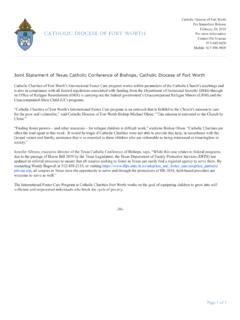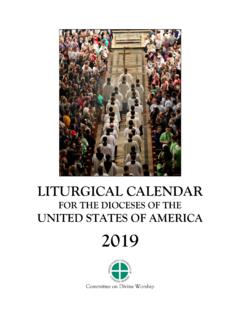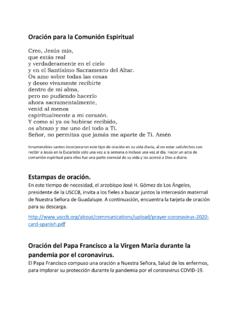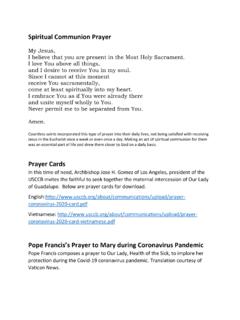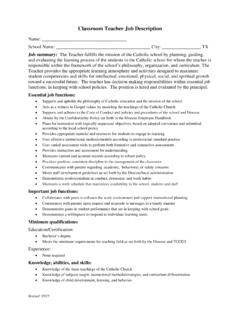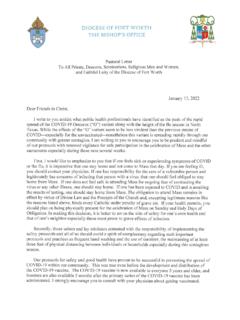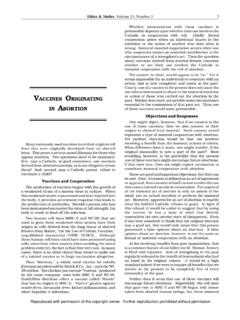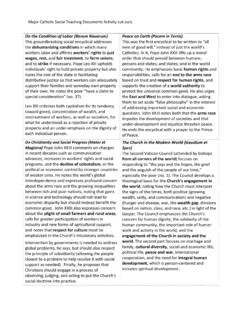Transcription of Documents of the Catholic Church on Mission
1 Mission Documents of the Catholic Church Page 1 Documents of the Catholic Church on Mission 1. Prope Nosti On the Propagation of the Faith a. Encyclical Letter of Gregory XVI, September 18, 1840 b. c. Summary: Gregory XVI (1831-1846) is generally regarded as the father of contemporary Catholic Mission for his enthusiastic support and energetic direction in the rebirth of missionary organization in the Church both lay and clerical as well as female missionary orders. (Valentine Ugochukwu Iheanacho, MCP. Maximum Illud and Benedict XV's Missionary Thinking: Prospects of a Local Church in Mission Territories.)
2 Saarbr cken: Scholars' Press, 2015., p. 56.) Encyclical reminds bishops that the propagation of the faith should not be limited to their own diocese but extended to whole world. Gregory XVI invites bishops to be active in missions and to get the laity to also be involved. 2. Maximum Illud On the Propagation of the Faith Throughout the World a. Apostolic Letter of Benedict XV, November 30, 1919 b. c. Summary: It deals with the Catholic missions after World War I. Pope Benedict XV recalled the great Apostles of the Gospel who contributed much to the Expansion of Missions.
3 He reviewed the recent history of the missions and stated the purpose of the Apostolic letter. The encyclical first turned to the bishops and superiors in charge of the Catholic missions, noting the need to train local clergy. Catholic missionaries are reminded that their goal is a spiritual one, which must be carried out in a self-less way. The Pope underlined the necessity of proper preparation for the work in foreign cultures and the need to acquire language skills before going there. He requests a continued striving for personal sanctity and praises the selfless work of female religious in the missions.
4 Mission is not only for missionaries, all Catholics must participate, through their Apostolate of Prayer, by supporting vocations, and by helping financially The encyclical concludes by pointing out several organizations which organize and supervise Mission activities within the Catholic Church . 3. Revrum Ecclesiae On Promoting the Sacred Missions a. Encyclical Letter of Pius XI, February 28, 1926 b. c. Summary: Its main passages deal with the founding, solidification, and independence of the new Three years earlier, the Congregation for the Propagation of the Faith sent directives to the missionary societies that clearly aimed at the assimilation of the Church into the missionary The work of the foreigners could be considered concluded as soon as the new foundation had established its own leadership, churches, native clergy, and funds, in short, as soon as it no longer needed the help of others.
5 At that stage its existence would no longer be threatened if the missionaries should be deported or fresh recruits from Europe should be reduced. For the creation of a Church , Rerum Ecclesiae demanded: an autochthonous clergy that would be compatible with the European clergy; autochthonous orders that would correspond to the expectations and interests of the natives as well as to the regional conditions and circumstances; an autochthonous monastic system because the contemplative monasteries offer irreplaceable contributions to the development of an individual Church .
6 34 autochthonous catechists, and an elite of laymen whose careful training could be of invaluable importance for the future of Church and 32] Sylloge. 240-58: De sacris missionibus provehendis Rerum Ecclesiae (28 February 1926); German: Marmy, Auf der Maur, 26-49. 33] "Decree of the Propaganda of 20 May 1923, Lo sviluppo (Sylloge, 213-17). 34] The Popes rarely discuss this (rather important) concern of monachism. Regarding the numerous native orders and congregations developing in India, see P. Rayanna, The Indigenous Religious Congregations of India and Ceylon (Tallakulam, Madura 1948); concerning the contemplative orders in Africa, cf.
7 Grands Lacs (Namur, Jan. 1956); I. Auf der Maur, "Werden, Stand und Zukunft des afrikanischen Monchtums," NZM 23 (1967), 284-95, 24 (1968), 2 1-35; P. Gordan, "Aufgaben und Probleme des benediktinischen Monchtums in Afrika," NZM 16 (1960), 186-92. 35] Pius XI devotes one chapter to the assistance provided by missionary doctors. +ecclesiae&source=bl&ots=xoSieY-kZW&sig= IuQ01 ECoc8wUUODqKLqEnuAyltU&hl=en&sa=X&ved=0a hUKEwjzuryo_5 DVAhXK6 YMKHXVYBns4 ChDoAQghMAA#v=onepage&q=rerum%20ecclesia e&f=false 4. Evangelii Praecones On Promoting Catholic Missions a.
8 Encyclical Letter of Pius XII, June 2, 1951 b. c. Summary: Issued on the 25th anniversary of Rerum Ecclesiae. Despite the interruption created by the Second World War, the missions had achieved a great deal. These achievements are listed in the encyclical, and include a steady growth in the number Mission Documents of the Catholic Church Page 2 of indigenous clergy and bishops. The letter emphasizes the importance of education, especially at a time when communism was spreading rapidly. An important command contained in the encyclical was that missionaries should respect the culture and customs of the people.
9 Let not the Gospel on being introduced into any new land destroy or extinguish whatever its people possess that is naturally good, just or beautiful. For the Church , when she calls people to a higher culture and a better way of life, under the inspiration of the Christian religion, does not act like one who recklessly cuts down and uproots a thriving forest. No, she grafts a good scion upon the wild stock that it may bear a crop of more delicious fruit. [# 56] Central themes: - Bring Christian truth to new peoples and form new Christians - Establish Church on firm and definite foundations among new peoples - Choose leaders for the people of the place - Called upon lay people to cooperate with clergy, to perform Catholic action, and to join associations that are in conformity with the Church in bringing social justice - Missionaries are not to crush good elements of local cultures, destroy fine arts, culture , customs, tradition and local feasts.
10 But to rather sanctify them and alter their meaning to celebrate the mysteries of faith or commemorate martyrs. 5. Fidei Donum On the Present State of the Catholic Missions Especially in Africa a. Encyclical Letter of Pius XII, April 21, 1957 b. c. Summary: Earlier attention of the Church had been focus on the Far East (esp. China), FD focuses its attention to the situation in Africa. 1957 is the year that many countries in Africa gained independence for their former colonial masters. The Church had not made as much progress here as the pope had wished.
